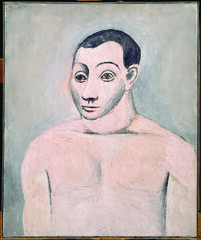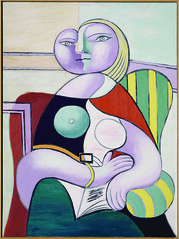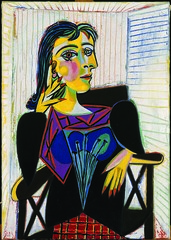
On our last day in San Francisco, Laura took us out for breakfast to a French restaurant Zazie, in Cole Valley. The restaurant is named after the French film Zazie dans le Métro based on a novel written in 1959 by Raymond Queneau.
In the film, provincial pre-teenager Zazie stays in Paris with her Uncle Gabriel (a female impersonator) for two days, while her mother spends some time with her lover. Zazie manages to evade her uncle's custody, and Métro strike notwithstanding, sets out to explore the city on her own. Will have to see the film.
On the wall of the cafe is a partial picture of Zazie. We were served proper French café au lait in steaming bowls.
Then we said goodbye to Laura, which was sad. Laura drove off to work, and Pat and I went to Golden Gate Park – this time the eastern end.

Firstly, we went past the Conservatory of Flowers. It was still early, so quite foggy.

The building reminded me of Kew gardens in London.
 Then lo and behold, the plaque advised us that the building was completed in 1879, and “patterned after the Conservatory, Kew Gardens, England, a distinguished example of late Victorian style.”
Then lo and behold, the plaque advised us that the building was completed in 1879, and “patterned after the Conservatory, Kew Gardens, England, a distinguished example of late Victorian style.”One of the many things that has impressed me about San Francisco and California, is that if they like something, from no matter what time or place, they are not afraid to copy it. We have seen quite a few examples of this.

It was too early to go into the conservatory, so we continued on our way through the mist.

Underpass – looks as though this could have been built in 1879 as well.

Underpass up closer.

Clever use of white succulents as a pen.

We continued along our merry way to the de Young Museum, past the Garden of Humanitarians.
Pat said he hadn’t been aware that humanitarians could be grown in a garden.

Picture from http://www.topsummerdestinations.com/
The de Young Museum originated as the Fine Arts Building, which was constructed in Golden Gate Park for the California Midwinter International Exposition in 1894. The museum’s name was changed to the M. H. de Young Memorial Museum after Michael de Young, the director of the Expo, who supervised much of the museum’s growth until his death in 1925. The building suffered significant structural damage in the 1989 earthquake, and the current building opened in 2005.
An interesting statistic: the new museum is the fourth most-visited art museum in North America, and the 16th most-visited in the world. So we weren’t alone there.

Historic elements from the former de Young, such as the sphinxes, the original palm trees, and the Pool of Enchantment, have been retained or reconstructed at the new museum.
This is one of two concrete sphinxes (c.1910) by Arthur Putnam (1873-1930) replacing originals from the entrance to the original Fine Arts Building of 1894. The building’s Egyptian Revival architecture reflected a fascination with ancient Egypt, inspired by archeological discoveries such as the 1858 excavation of the Great Sphinx at Giza.

Gustave Doré (1832-1883)
Poème de la Vigne (cast in bronze in 1882)
Gustave Doré created this vase for French winemakers, who exhibited it at the 1878 Paris World’s fair. It was later exhibited at the Chicago World’s Columbian Exposition of 1893, then the famous California Midwinter International Exposition of 1894. It was purchased by guess who, Michael de Young (he must have had a large garden) who later donated it to the de Young Museum.
We were going to the de Young Museum to see a magnificent exhibition entitled Picasso: Masterpieces from the Museé National Picasso, Paris. This exhibition consisted of more than 150 Picasso masterpieces from this gallery, available because the gallery is currently closed for renovations. The Musée Picasso’s holdings stand apart from any other collections of Picasso because they represent the artist’s personal collection - works that the highly self-aware artist kept for himself with the intent of shaping his own artistic legacy.
We were able to see paintings, sculptures, drawings and prints from different phases of his astonishing career, such as the Blue, Rose, Expressionist, Cubist, Neoclassical and Surrealist periods. (All right, I did copy that bit from the brochure, I can’t claim to have remembered all that.)
Here are some of the exhibits we saw:

Self Portrait (1906)
Gallery 2: Expressionism
Picture from www.flickr.com/photos/warholian

Les Baigneuses (1918)
Gallery 3: The Cubist Years, 1909-1918.
Picture from http://www.musee-picasso.fr/

La Course (1922)
Gallery 4: Neoclassicism, 1918 – 1924.
Picture from http://www.seattlegayscene.com/

Grand Nature morte au guéridon (1931)
Gallery 5: Surrealism, 1925 – 1935.
Picture from www.flickr.com/photos/warholian

La Lecture (1932)
Gallery 6: The Spanish civil War and the Weeping Woman, 1936 – 1939.
Picture from www.flickr.com/photos/warholian
 Portrait of Dora Maar (1937)
Portrait of Dora Maar (1937) Gallery 7: World War 11 and the Korean War, 1939 – 1953.
Picture from www.flickr.com/photos/warholian

Le Baiser (1969)
Gallery 9: Late Work, 1961 – 1973.
Picture from www.flickr.com/photos/warholian
It was interesting (and I’m sure no coincidence) that the San Francisco Museum of Modern Art (SFMOMA) was showingThe Steins Collect: Matisse, Picasso, and the Parisian Avant-Garde, The Contemporary Jewish Museum (CJM) was showing Seeing Gertrude Stein (who was best-known for her patronage of vanguard painters, most notably Matisse and Picasso, in Paris before the First World War) and that the de Young Museum was showing this Picasso exhibition.
We were very lucky to have gone to all three of these exhibitions (Pat may not agree about the Gertrude Stein one).
Although reeling from sensory overload, we then called in at the Conservatory of Flowers, which was now open.






This is an aerial view of Golden Gate Park (picture by Alexander Marks, from Wikimedia Commons). It’s about five kilometres long and a kilometre wide.
The western end, which finishes at the beach (which we’d visited another day with Laura) is on the right of this picture, and the eastern end, where the De Young Museum is, is on the left. We haven’t visited the middle yet.
Apart from the attractions we’ve seen, the GG Park also includes the Spreckels (there’s that name again) Temple of Music, the Academy of Sciences (one of the largest natural history museums in the world), the Japanese Tea Garden, an AIDS Memorial Grove, the San Francisco Botanical Garden, the Golden Gate Park Stadium, Hippie Hill (a popular gathering-place for hippies during the 1967 Summer of Love, and no doubt since). There are also countless minor attractions. We’ll have to go again.

From the eastern end of GG Park, it was about an hour’s walk back to Laura and Arend’s place, with those stunning San Francisco views along the way.
No comments:
Post a Comment